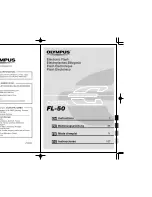
TECHNICAL DETAILS
76
Camera Type:
IX240 Lens Shutter Type
Lens:
30-90mm f/3.6 - 10.3 power zoom lens (equivalent to 38 to 113mm in the 135
system). 4 element/4 group construction including 2-two-sided aspheric ele-
ments. Maximum magnification 1/4.3X (Close-up mode focal length = 75mm)
Focusing Range:
C / H: Wide / Tele 0.5m -
∞
/ 0.6m-
∞
(Close-up 0.4m-
∞
)
P: Wide / Tele: 0.5m -
∞
/ 0.8m -
∞
(Close-up 0.7m-
∞
)
Film Speed Setting:
Automatic setting for DX coded films ISO 25 - 3200
Metering Range (ISO 200): Wide: EV 3.0 - EV 17
Tele: EV 3.7- EV 17
Flash Range (ISO 200):
Wide: 0.5 - 7.9m (1.6 - 25.9 ft.)
Tele: 0.6 - 2.7m (2.0 - 8.9 ft.) (Close-up: 0.4 - 3.2m)
Battery:
One CR-2 3V Lithium battery
Battery-condition indication: 3-stage indication
Battery performance: approx. 12 rolls based on Minolta’s standard test
method using 25 exposure rolls with the flash on for 50% of the exposures.
Viewfinder:
Magnification: 0.44X - 1.19X
Field of View (H format): 85% (for subject at 3m)
Eyepoint: 27mm
Dimensions:
117.5 x 65 x 48.5 mm (4.63 x 2.56 x 1.91 in.)
Weight:
240g (8.46 oz.) without battery
• Specifications are based on the latest information available at the time of printing and are subject to
change without notice.
This device complies with Part 15 of the FCC Rules. Operation is subject to the following two conditions: (1) This device
may not cause harmful interference, and (2) this device must accept any interference received, including interference
that may cause undesired operation. Changes or modifications not approved by the party responsible for compliance
could void the user's authority to operate the equipment. This equipment has been tested and found to comply with the
limits for a Class B digital device, pursuant to Part 15 of the FCC Rules. These limits are designed to provide reasonable
protection against harmful interference in a residential installation. This equipment generates, uses and can radiate radio
frequency energy and, if not installed and used in accordance with the instructions, may cause harmful interference to
radio communications. However, there is no guarantee that interference will not occur in a particular installation. If this
equipment does cause harmful interference to radio or television reception, which can be determined by turning the
equipment off and on, the user is encouraged to try to correct the interference by one or more of the following measures:
• Reorient or relocate the receiving antenna.
• Increase the separation between the equipment and the receiver.
• Connect the equipment to an outlet on a circuit different from that to which the receiver is connected.
• Consult the dealer or an experienced radio/TV technician for help.
This Class B digital apparatus meets all requirements of the Canadian Interference-Causing Equipment Regulations.


































